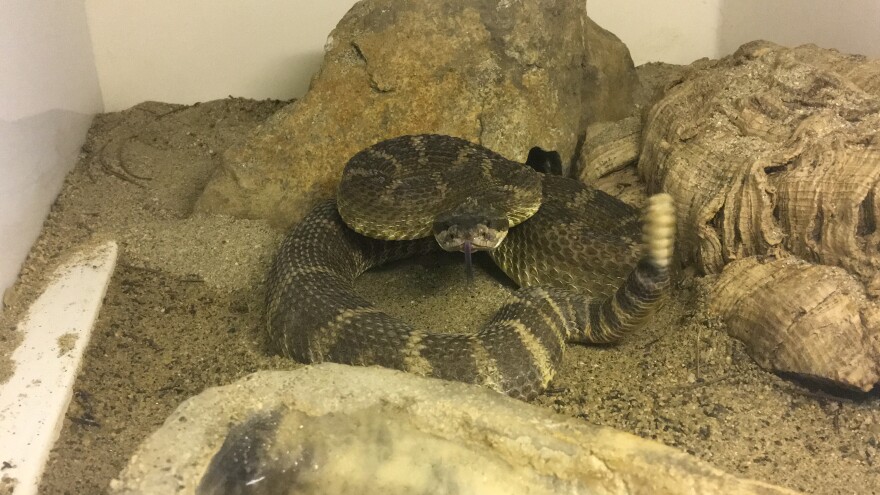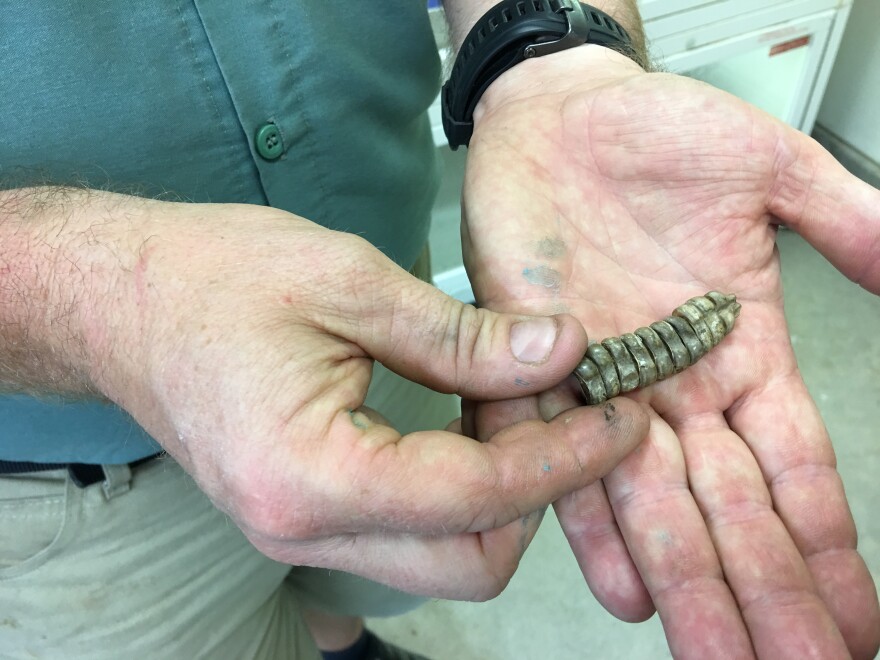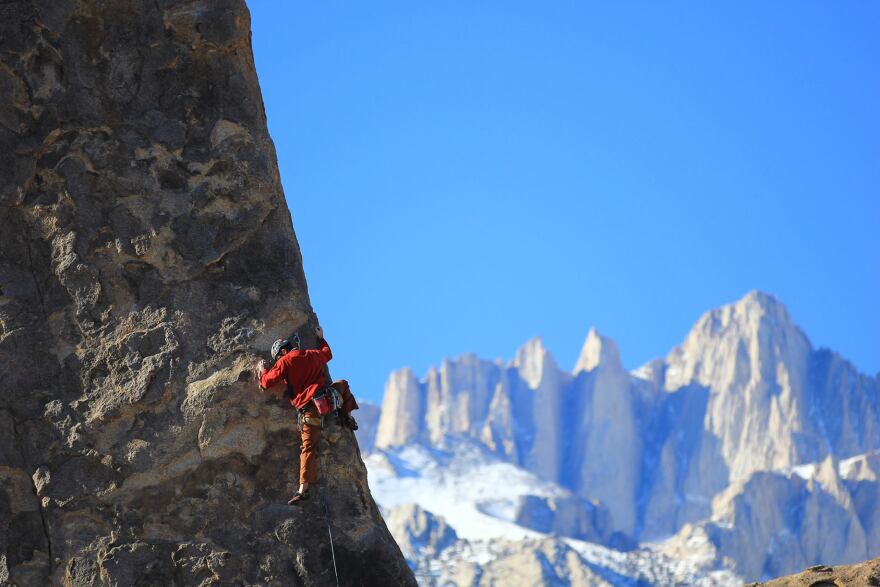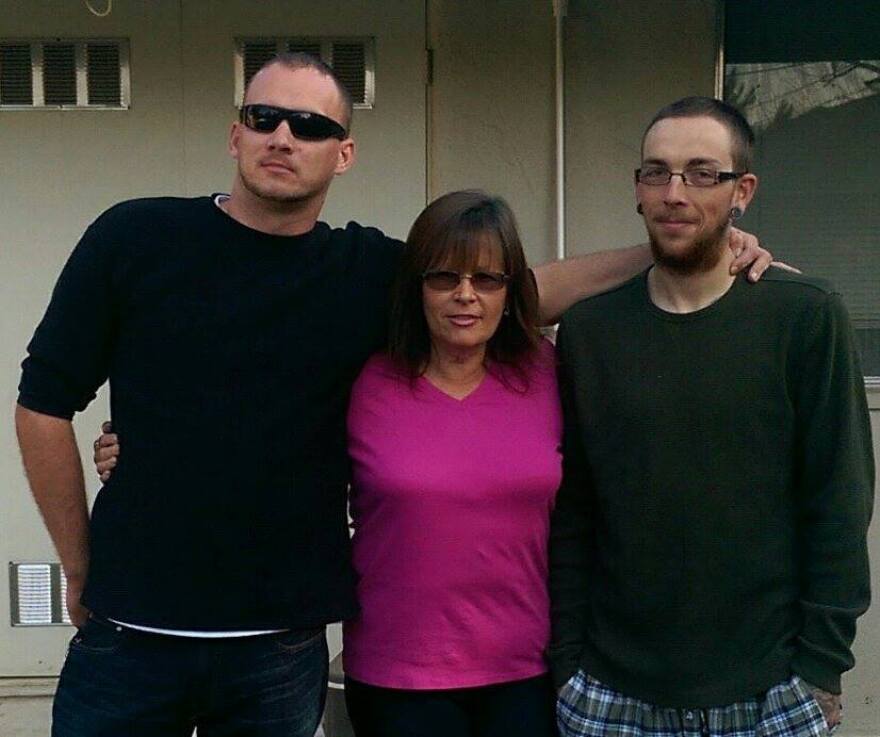Spring is here and it’s the perfect time to get outdoors. There are, of course, lots of fun things to do outside this time of year, but one sport is attracting locals specifically to rock faces everywhere.
"Fresno and the surrounding areas is one of the best places to live if you're a climber." - Daniel Suvanto
Today’s episode focuses on that activity, and especially on safety. We’re talking about rock climbing, which may sound intimidating, but when done right is actually very safe. In this episode we talk climbing basics, staying safe from one particular critter that could really ruin your climbing trip, and we meet a local climber with an unusual—and heartbreaking—reason for getting into the sport.
Central California is a great place to live if you’re into rock climbing, so we decided to learn how. Kerry’s a regular climber, but Ezra’s not a big fan—so, naturally, we sent him to take a lesson. He took our intern, Laura Tsutsui, to Metalmark, Fresno’s local climbing gym. It was her first time ever climbing, and she’s not crazy about heights—so this sounded like a fun experiment.
We met Daniel Suvanto at MetalMark. He’s an avid climber and Metalmark employee.
“I think Central California climbing is awesome,” Daniel says. “Fresno and the surrounding areas is one of the best places to live if you’re a climber, I think. Once you put your time in in the gym you can move to tons of different areas in the surrounding mountains.”

Areas like Tollhouse, Shuteye Ridge near Bass Lake, the Tehachapi Mountains, Joshua Tree National Park, the Eastern Sierra, and one of the original climbing meccas: Yosemite Valley.
Daniel says there are lots of ways to get started climbing—beginning with one that requires hardly any gear.
“The smallest one would be bouldering,” he says. “So what bouldering involves is basically you, your shoes, your chalk bag and then a crash pad. What you’re doing is climbing up a boulder and the boulders can range from anywhere from six feet to 30 feet and they’re really hard moves. Sometimes they could be overhung.”
Climbers use chalk to get a better grip on the rock, and they lay down crash pads, thick foam covered in fabric, in case they fall.
"So really important in climbing is making sure that we check each other." - Daniel Suvanto

But when you think rock climbing, you may picture people dangling on ropes. That’s the next level up from bouldering. The easiest is called top-roping, which is where the rope is already set up for you and anchored at the top of the route. Climbing routes are specific paths up rock faces, and they’re graded based on how difficult they are.
And then there is sport or lead climbing where you clip the rope to carabiners that are already attached to the wall. Carabiners are metal clips that can hold the rope and your weight.
“The next step up from that would be called ‘trad’ climbing or traditional climbing,” Daniel says. “You’re climbing up and putting equipment into a crack or wrapping a sling or a piece of rope around a tree and you’re actually creating your own protection as you climb up.”
There’s another type where you’re not really climbing the rock, but your equipment. As you move up a rock face you take your protective equipment with you. It looks hard—and time-consuming. And then there’s the most extreme type of rock climbing, called free soloing. Where there’s no ropes at all. Just chalk and your body. It’s what Tom Cruise was doing in the opening scene of Mission: Impossible II.
So if you’re a newbie, what’s the best way to get started? Daniel says all you really need is chalk, shoes and a harness. All this can cost up to around $200 new, or you can rent it at Metalmark when you take a beginner class or try it with friends. A basic membership runs about $60 a month and includes free beginner courses. When you climb on your own outdoors you’ll also need ropes, a helmet, and other hardware like carabiners.
"You get all the benefits of a community and it's all just in the name of fun. Everyone's here to have a good time." - Daniel Suvanto

So we decided Laura would give a beginner route a shot, and we learned how to use all this equipment. Climbing shoes look like hybrid jogging shoes and ballet slippers with a slick rubber sole hugging the arch of the foot. Daniel says they should be tight with your toes touching the tip of the shoe.
“They feel pretty snug,” Laura says, dubiously. “Snug would be the perfect word,” Daniel says.
Next up: a harness, which wraps around your waist and legs, with lots of loops for carabiners and your rope. Laura ties one end of the rope into her harness, and Daniel ties the other end into his. He’ll be belaying Laura, which means he’s in charge of the rope. He can pull it tight for Laura, and stop it if she falls.
Before she gets on the wall, though, Daniel does a quick safety check.
“So really important in climbing is making sure that we check each other,” Daniel says. “I can check your harness and you’re double backed. You’re going to do the same to me.”
Daniel makes sure they’ve both tied the proper knots, and he makes sure his belay device is locked. All this is important to make sure that nothing goes wrong.
“Are you on belay?” she asks. “I am on belay,” he responds—typically rock climber lingo shared before starting an ascent.
Laura’s about to climb a 50-foot grey wall covered with multicolored pieces of plastic she’ll grab and step on to reach the top. They come in lots of different shapes and sizes, and some are easier to hold onto than others.
“This ring thing is really like intimidating,” she says as she begins.

“Remember stand up on your left foot,” he shouts as she ascends up the wall. “Awesome!”
When she got to the top, she laid back and got ready to come down. Daniel let her down by running the rope through a piece of equipment attached to his harness.
Laura says not looking down was key to making it to the top. But she did, and she says it was satisfying to touch the top and realize she just scaled this wall with her own body strength. “There were moments where I was like, I need to hold so hard with my hands right now that they feel like they’re cramping.”
“The first time, you realize you don’t need to, like, break the rocks,” Daniel laughs. “So you can hold a little bit less hard.”
Despite the heights, Laura wants to come back and try it out again. Daniel says: anytime.
“It’s so much fun,” he says. “You get all the benefits of working out. You get all the benefits of a community and it's all just in the name of fun. Everyone’s here to have a good time.”
Watch Out For Rattlesnakes

So you have your climbing shoes, ropes, carabiners, chalk and all that. But one major safety consideration we haven’t talked much about is protection against what lives outdoors. We’re not talking about bears, which are around but are unlikely to attack, but about another creature that may present even more of a threat.
Imagine you're climbing a series of boulders. As you reach up over the last ledge your fingers don’t touch rock. You feel something scaly and then you hear that iconic rattle.
Rattlesnakes. Mark Halvorsen knows a lot about them. He’s the Fresno Chaffee Zoo Curator of Reptiles.
"A rattlesnake bite is a life threatening emergency."- Mark Halvorsen

“Once you’re outside of town on your trails and you’re heading out rock climbing, there’s a pretty good chance there’s going to be some rattlesnakes around,” he says. “In addition, rattlesnakes like spending time in and around rock clusters because that’s where they will overwinter. So in the spring and early summer is when they come out of those areas so they tend to concentrate near that spot.”
Growing up in the Central Valley, Ezra’s seen lots of snakes—on the farm, on trails in the mountains and dead on the highway. But today was the first day he’d seen one up close—well, behind a glass enclosure at the zoo.
“A rattlesnake bite is a life threatening emergency,” Mark says. “That being said, being bitten by a rattlesnake does not condemn you to do die immediately. You have several hours before you have major problems.”
Mark says this is the time of year that rattlesnakes come out of hiding and are on the lookout for food, like rodents. Rattlesnakes don’t hibernate, but since they’re cold blooded they take it easy for the winter and get hungrier and more active when the weather warms up.
That’s great for these Northern Pacific Rattlesnakes, but not for humans on outdoor adventures.
“Rattlesnakes like to sit and wait for prey to come along,” Mark says. “So they’ll be in the high grass and rock piles and things like that. So if you’re approaching those things, don’t put your hands or legs in places you can’t see.”
The snakes’ rattles are made of a series of hollow segments made out of a stiff material called keratin that they shake together by vibrating their tails. Baby rattlesnake are actually born with a button instead of a tail and every time they shed, they grow a new segment.
Mark says rattlesnakes don’t actually want to bite you, so they use their rattle as a warning system.

“They’re low-key. They rattle to let you know and their last defense, the last thing they’re ever going to try to do is bite,” he says. “They’ve invested an incredible amount of energy out of their body to create this venom, which is essential to their diet. They need to be able to bite this animal and start the digestive process. Why would they want to waste that? They’re going to rattle and let you know they’re their. If you continue to press they are going to try to move away, but if you keep pressing and try to pick them up they are probably going to try to turn around and bite.”
But what if the worst happens while rock climbing and rattlesnake sinks its fangs into your skin? What do you do? Mark has the answer.
“If you are unfortunate enough to actually get bitten by a rattlesnake, number one, hopefully you have a friend nearby to make it easy on you. If you don’t, just remain calm,” he says. “There are a lot of stories that say suck out the venom or electrify it with a battery or use a tourniquet to close off the area. You don’t want to do that. You just want to stay calm, start getting out of there, and get some immediate medical help. Call 911. Get someone out to help you.”
Dogs are at risk of rattlesnake bites, too. Mark says there are trainings for dogs to become rattlesnake averse. Plus, there’s a rattlesnake vaccine that helps slow down the spread of venom in the body.
He says there already have been several rattlesnake bites in the Fresno area this spring, and the best way to avoid a bite is to just give the animals their space.
“The vast majority of bites that happened in any given year are either children kind of running around rampant and get exposed or someone who is trying to pick up and kill a rattlesnake,” he says. “They’ll either try to chop off the head or then try to pick up the animal and, actually, they still have a reflex reaction where they can still bite. The best answer is just leave rattlesnakes alone.”
Turning Tragedy Into Top-Roping
Safety is no joke while climbing. Rattlesnakes are a big deal, but it’s also critical to take care of your equipment and take care of all the safety checks Daniel and Laura went over earlier. If you forget, things can go south. That’s something Stacey Byers-Richardson knows well. Kerry went climbing in Yosemite National Park earlier this spring with her and a few of her friends.

Stacey’s 51, she started climbing just two years ago, and she’s a pretty advanced climber. But it's not how well Stacey climbs that makes her story extraordinary. It’s why she climbs. It has to do with her son Cody, who was climbing in Yosemite two years ago.
“He was on Royal Arches for at least the fifth time,” she says. ”They [Cody and his climbing partner Eric] were rappelling down, ledge to ledge to ledge, and he didn't tie his knot at the end of the rappel rope.”
Cody fell a few hundred feet and died.
"I get angry with him, knowing how he passed was such an easy thing, it was just tying of a knot at the bottom of his rappel rope." - Stacey Byers-Richardson
“It slipped through,” she says, and Cody's gasp “was the last thing Eric said he ever heard."
While this is sort of a cautionary tale, it’s really a story about a mother, her son, and the community that came together around his death.
Stacey started climbing after Cody died in order to be closer to him. “Just to figure out what made him tick,” she’ll say. It’s now an intrinsic part of her life—just like it was for him.
“He lived, breathed and ate climbing,” she says. “It was his passion more than anything. He'd go to bed thinking about it, he'd get up thinking about it, he'd ride 20 miles in a bicycle to go to work and then go to the gym after. I’m like, that’s some dedication.”
When you get to be that good, that’s when autopilot can kick in and you overlook or forget your safety precautions. One knot could have saved Cody’s life.

“I get angry with him, knowing how he passed was such an easy thing, it was just tying of a knot at the bottom of his rappel rope,” Stacey says. “So every time I rappel, I curse at him. In my head, thinking, all you had to do was tie your knot, that's it.”
Cody was 24 years old. Still finding his way in life. He grew up in Fresno, Stacey’s only child.
“He was a great kid,” she says. “It was him and I against the world his whole life. He wanted to go to the army after high school to see what the world had to offer, travel the world, he thought, and he hated it. Hated it from day one. So he did 555 days and he was honorably discharged. Then he came home, got into climbing, and the rest is history.”
When Cody died, Stacey didn’t know anything about climbing. That part of Cody’s life was a total black box to her. But once he was gone, it took only four days for Stacey to change her mind and finally set foot in the gym.
"I lost 35 pounds. It just kind of melted off. And now I've kept it off for two years and gotten in literally the best shape of my life." - Stacey Byers-Richardson

“It was awe inspiring,” she says. “I'm like, whoa. Never had I been in a gym. I was too overweight to even think about climbing.”
Suddenly, she was thinking about it. She introduced herself to Cody’s friends and they convinced her to try out a beginner climb—the same one Laura tried out last week.
“It was hard,” Stacey says. “It was the easiest route in the gym. I was halfway up and thinking I was gonna die. My hands were gonna fall off, my feet were like Jell-o, my legs were wobbly. It's pretty hilarious compared to what I am now.”
That first time, she could only climb one route before getting tired out. But she was determined to improve. Now, she climbs a few times a week, five or 10 routes in a session, and they’re way beyond that easy route. She also takes a lot of fitness classes.
“I lost 35 pounds,” she says. “It just kind of melted off. And now I've kept it off for two years and gotten in literally the best shape of my life.”
Stacey’s more social, too. Cody’s friends are now her friends. They climb together, they’ve spread his ashes together, and they always round out a day in Yosemite with an Oreo milkshake from Robert’s Frosty in Coarsegold—Cody’s favorite.
When some of Stacey’s new friends told her they weren’t sure they could climb again after the accident, she would have none of it.

“I said, no: Cody would be pissed at you if you didn't climb again,” she says. “You have to climb. Cody would be so mad and give you guys such grief so you have to. So they did. They got back on the horse.”
It’s that tight-knit climbing community Daniel mentioned earlier. For two years, they’ve all been helping each other to heal communally. This mother who lost her 24-year-old son is the one telling his friends to pick themselves back up. And in turn, they adopted her, welcoming her into their fray and sharing stories about Cody.
“Cody's friends that I inherited are the best people in the world,” Stacey says. “They literally saved my life, and that's the honest to God truth. I’ve turned the most negative thing any parent could ever imagine into the greatest thing.”
"I’ve turned the most negative thing any parent could ever imagine into the greatest thing." - Stacey Byers-Richardson

She says you can’t let yourself be paralyzed with fear.
“[Climbing’s] not sketch—it’s, I think, one of the safest things you can do,” she says, “especially if you have the right people with you. The right gear, the right attitude, right place, right time, right people.”
Now, Stacey says she’s kind of like the gym mom. And still gets to be a mom outside the gym, too. About two years before Cody passed away, a son Stacey had given up for adoption decades ago did some sleuthing and found her and Cody online. They reconnected. They get along. And now, Stacey has a granddaughter.
“Being called grandma is the best—the absolute best,” she says. “I never thought I'd be a grandma. Ever. Cause I didn’t think Cody would have a kid, and if he did it’d be a long time from now. So having Maci is a blessing.”
None of this replaces Cody. Nothing can. But it gives Stacey satisfaction to know she’s doing as much as she can with the memories, the friends, and the climbing shoes Cody left behind.







